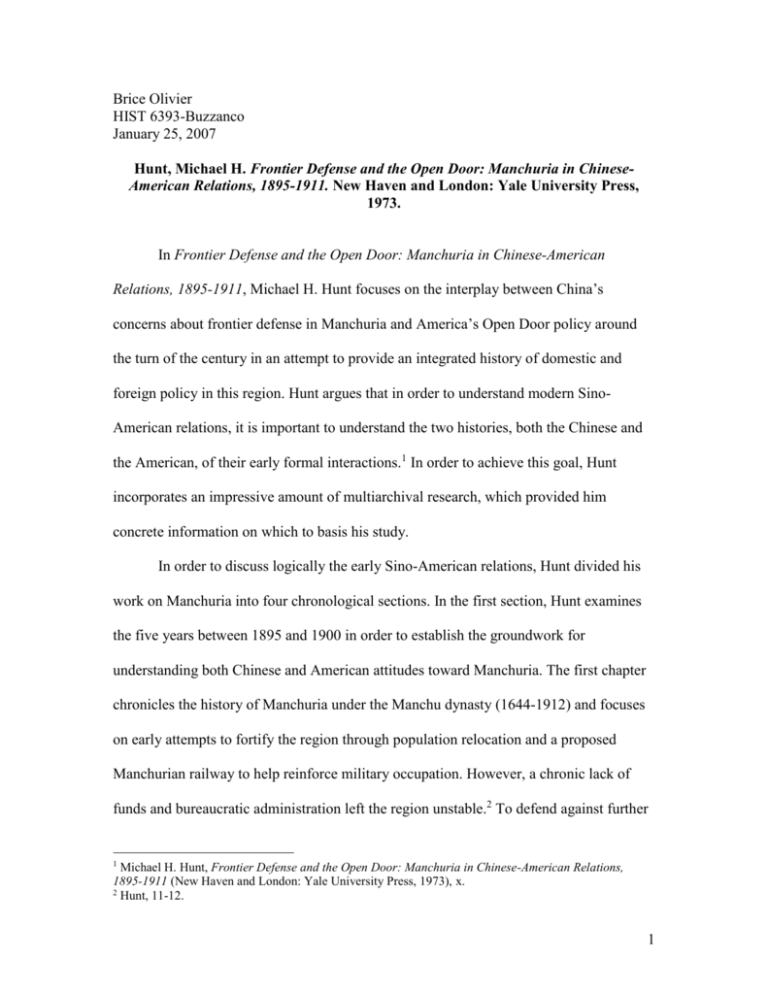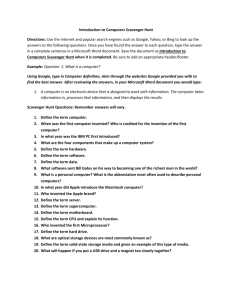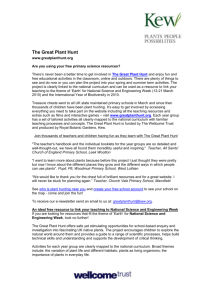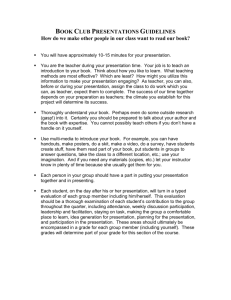Brice Olivier - Department of History
advertisement

Brice Olivier HIST 6393-Buzzanco January 25, 2007 Hunt, Michael H. Frontier Defense and the Open Door: Manchuria in ChineseAmerican Relations, 1895-1911. New Haven and London: Yale University Press, 1973. In Frontier Defense and the Open Door: Manchuria in Chinese-American Relations, 1895-1911, Michael H. Hunt focuses on the interplay between China’s concerns about frontier defense in Manchuria and America’s Open Door policy around the turn of the century in an attempt to provide an integrated history of domestic and foreign policy in this region. Hunt argues that in order to understand modern SinoAmerican relations, it is important to understand the two histories, both the Chinese and the American, of their early formal interactions.1 In order to achieve this goal, Hunt incorporates an impressive amount of multiarchival research, which provided him concrete information on which to basis his study. In order to discuss logically the early Sino-American relations, Hunt divided his work on Manchuria into four chronological sections. In the first section, Hunt examines the five years between 1895 and 1900 in order to establish the groundwork for understanding both Chinese and American attitudes toward Manchuria. The first chapter chronicles the history of Manchuria under the Manchu dynasty (1644-1912) and focuses on early attempts to fortify the region through population relocation and a proposed Manchurian railway to help reinforce military occupation. However, a chronic lack of funds and bureaucratic administration left the region unstable.2 To defend against further 1 Michael H. Hunt, Frontier Defense and the Open Door: Manchuria in Chinese-American Relations, 1895-1911 (New Haven and London: Yale University Press, 1973), x. 2 Hunt, 11-12. 1 aggression, China entered into a alliance with Russia, but the concessions made by China result in Russian control over certain major railways and, by 1901, Russian occupation of the region.3 In Chapter Two, Hunt switches from the Chinese perspective and focuses on early American interest in Manchuria. Hunt introduces the two major strains of American political thought toward the region as the Open Door and the “activist” lines of reasoning.4 The traditional view of the Open Door allowed all nations equal rights and access to Chinese markets. Gradually spheres of influenced developed, which led to a group of Americans, the activists, to advocate for either the development of an American sphere (potentially in Manchuria) or the dissolution of other spheres in China. Hunt concludes this section by discussing some of the initial problems between America and China including access to naval ports, discrimination against Chinese in America, and the massacre of missionaries in China, which contributed to a general feeling of mistrust. In Part Two, Hunt focuses on the period between 1901 and 1907. One of the major issues for both China and America was the right of China to open and operate naval ports to increase commerce in Manchuria, which the Russians claimed as a right granted to them in a previous treaty. This was a particular interest of the United States since access to naval ports was vital to commerce in the region. Another issue during this period was the influence that W. W. Rockhill, an American representative in Peking, had on Secretary of State John Hay’s understanding of the open door. Rockhill suggested that any threat to the integrity of China in Manchuria would result in a threat to the open door 3 4 Hunt, 15-17. Hunt, 27. 2 policy throughout China.5 Hunt argues that Rockhill’s influence confused the issue of the open door since it elevated China’s integrity over commercial opportunities, which was in direct contrast to the spheres of influence generally supported by the American State Department.6 Another issue examined was China’s need for a strong ally and America’s general disinterest during this period to support China against Russia and Japan. This disinterest grew after 1906 when American commerce in Manchuria began to decline.7 The third part of Hunt’s work examines the short period between 1907 and 1908, when the Americans and Chinese first began to cooperate to defend and invest in Manchuria. Hunt opens this section with a discussion of the Chinese Wai-Pu (foreign ministry) under Yüan Shih-k’ai, who was more aggressive than earlier ministers were in regards to defense in Manchuria. During these two years, the Chinese advanced two major projects with which they hoped to receive further American support in Manchuria. The first project, the development of the Hsinminfu-Fakumen railway project interested American investors such as E. H. Harriman, but a minor recession and increased mistrust caused the failure of the railway. The second project was the development of a financing bank to fund improvements in Manchuria, which also failed as a result of mistrust and misunderstanding between American policy makers and their Chinese counterparts. In the final section of this work, Hunt examines what he calls “the second attempt at cooperation,” which occurred between 1909 and 1911.8 He begins this section by examining how the change in regimes in both China and America altered policies toward each other and Manchuria. The rise of President William Taft and his Secretary of State, 5 Hunt, 65. Hunt, 65. 7 Hunt, 109. 8 Hunt, 179. 6 3 Philander Knox gave way to the implementation of Dollar Diplomacy in China. The deaths of the empress dowager and the Kuang-hsu Emperor led to an overturning of officials both in the central Chinese government and in Manchuria, with the new governor-general in Manchuria espousing a more aggressive frontier policy centered on the old issue of railways. Hunt follows his examination of the regime changes by discussing the how a general lack of information and mistrust continued to hinder common plans, like the one to build a new railway in Manchuria. Ultimately, Hunt shows how the Sino-American plans in Manchuria failed, party because of Knox’s arrogance and inexperience with dealing with multinational diplomacy and partly because of the overall international atmosphere of many countries (Russia, Japan, Britain, Germany) toward the region. Hunt’s Frontier Defense and the Open Door does a good job of incorporating both the Chinese and the American issues of domestic and foreign concerns during the period under discussion. His incorporation of Chinese-language sources is impressive and provides an excellent foundation for his arguments in this work. While many historians have rightly hail Hunt’s work as an excellent contribution to the field of Sino-American studies, this work does suffers from several problems. At various points, this work is both repetitive and difficult to follow. The incorporation of personal background histories for many of the persons introduced is interesting, but at times overshadows the overall thesis and inhibits the flow of this work. However, the largest problem with this study is a lack of a coherent and identifiable thesis, which leaves the reader clear about the purpose of the work, but uncertain about the fundamental argument that should tie the work together. 4









